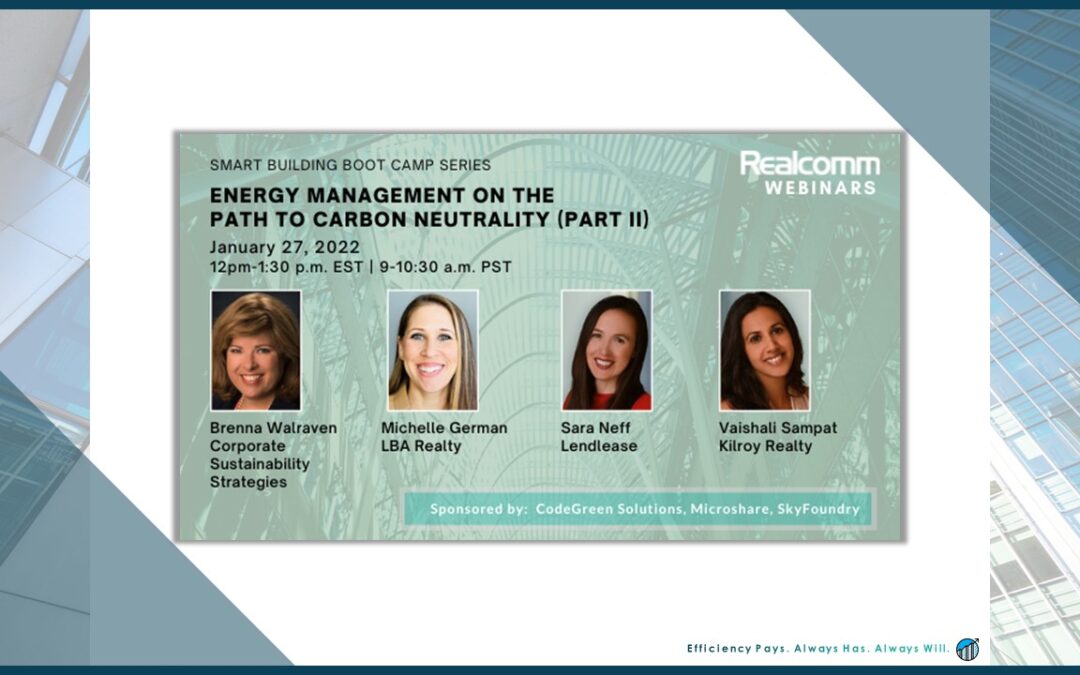
Jan 25, 2022 | Events, Homepage
Presented by Realcomm
Session Information
Intelligent building technologies are a critical component to realizing operational cost efficiency, healthy work environments, risk management and the experiences that define the smart building of the future. This series presents industry use cases for design, development and management of smart, energy efficient, high-performance buildings and examines how to create and execute a smart building strategy in the current environment, applying time tested principles to achieving a future ready and scalable approach for your project and/or portfolio.
Across the US, building owners and operators are tasked with making energy efficiency upgrades and/or decarbonizing their power supply to meet new emission reduction targets. This session reviews best practices for operational efficiencies and showcases portfolios that are committed to reducing embodied carbon emissions.
Panel
When
Thursday, January 27, 2022
12:00 PM – 1:30 PM ET
9:00 AM – 10:30 AM PT
Where
LIVE Webinar
More Information & Registration
About Realcomm
Realcomm was founded with the goal of bringing industry leaders together to discuss, demonstrate, and debate the latest innovations to impact the commercial real estate industry.
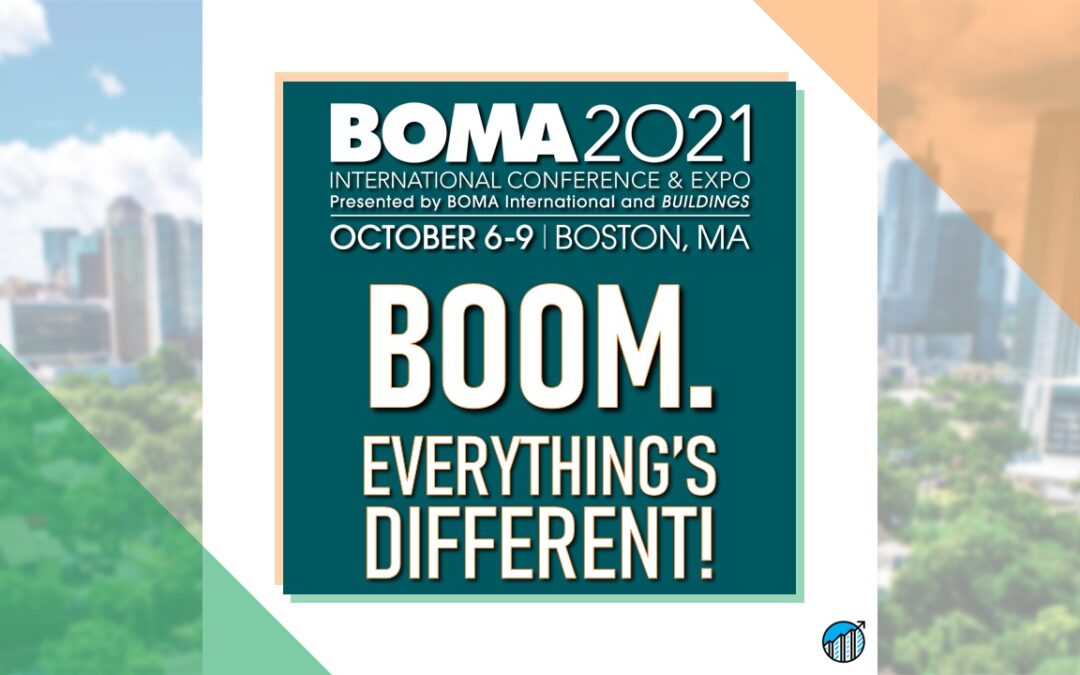
Sep 14, 2021 | Events, Homepage
Presented by Building Owners and Managers Association International Conference & Expo
Session Information
Tenants are increasingly not only looking for the best located, well-built buildings, but also for how they can meet their own sustainability objectives without sacrificing business success.
Focus
- Addressing challenges and opportunities to support greater ESG outcomes in net leased, tenant-controlled environments
- Best practices for addressing utility data and efficiency upgrades
- Leveraging opportunities for sustainability within distribution, warehouse, and logistics real estate (which also applies to any net leased asset – retail, office, mixed-use)
Panel
When
October 8, 2021
9:30 AM – 10:30 AM
Where
Boston Convention and Exhibition Center
Boston, MA
More Information & Registration
About BOMA International Conference & Expo
This year’s theme “Boom. Everything’s Different” speaks to the immense disruption, change, and opportunity that today’s commercial real estate professionals are navigating. The BOMA 2021 education program has been designed with the challenges of this moment in mind, offering more than 40 sessions on relevant topics like the evolving workplace, workforce development, and emerging technologies. Organized across eight distinct focus areas, attendees can customize their itinerary and select topics corresponding with their own educational needs. Whether it’s exposure to new technology, tips for increasing asset performance, or a fresh approach to a frequent tenant issue, seasoned industry veterans and emerging professionals alike can expect to learn something new at BOMA 2021.
About BOMA International
Founded in 1907, the Building Owners and Managers Association (BOMA) International is a federation of U.S. local associations and global affiliates. The leading trade association for commercial real estate professionals for more than 100 years, it represents the owners, managers, service providers, and other property professionals of all commercial building types, including office, industrial, medical, corporate, and mixed-use. BOMA International is the partner individuals in the commercial real estate industry choose to maximize value for their careers, organizations, and assets. Its mission is to advance a vibrant commercial real estate industry through advocacy, influence, and knowledge.
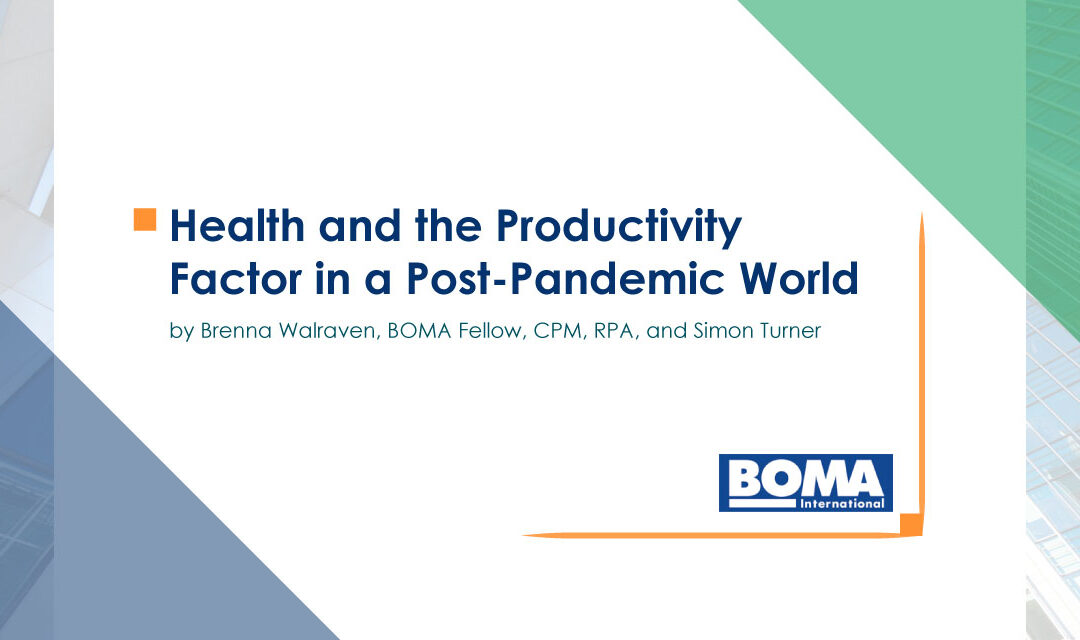
Apr 23, 2021 | Articles, Homepage
by Brenna Walraven, BOMA Fellow, CPM, RPA, and Simon Turner
Evidence of humankind’s long-standing battle against infectious diseases traces back thousands of years. There have been about 20 known pandemics in recorded history, and in some instances, they have led to an enhanced understanding of health and wellness issues and better approaches for safely navigating the world. The cholera epidemic that struck London in the mid-nineteenth century, for example, famously led to reforms in public water and sanitation systems. A decades-long campaign to distribute and socialize the use of mosquito nets has curtailed malaria. SARS, H1N1 and MERS were throttled by sophisticated pandemic control, including rapid behavioral changes, such as mask-wearing. Over the past 150 years, both the science of epidemiology and acceptance of disease control as a societal responsibility have come of age. Now more than ever, it’s clear that modern buildings must also contribute to life safety and health in the workplace.
As we prepare for a post-COVID-19 world, what practices will survive to confront pandemic preparedness in the future? Much has been written about remote work being here to stay, but the commercial real estate industry is banking on a basic human need for connection. The human species has evolved to congregate, and businesses know that ideas spring from being together, as in-person interactions spark creative thinking. It would be unwise to write off the office, but wise to reimagine its format.
Post-pandemic best practices will favor workplaces that create more space, higher ventilation rates—potentially even double the current ASHRAE minimums—and focus on how air is moved around buildings. Other changes will include open spaces, displacement ventilation, connections to the outside (both physically and via views), better lighting, more inviting stairwells, less reliance on elevators and more walkable spaces. For high-rise buildings, new elevator technology with vertical airflows and lower occupant density seems a sure bet, as is more touchless technology.
We can expect investments in buildings to respond to a market demand not just for COVID-free spaces, but healthier and more productive spaces. There is a great deal of research linking the factors that generate health and productivity in the workplace to substantial “bottom line” figures. Business owners are already familiar with utilizing financial analysis to make decisions, such as which space to lease. If building owners, property managers and leasing teams can discuss health-related features in these terms, they are likely to find a receptive audience.
The Fundamental Six
Listed below are six categories that are poised for growth in the post-pandemic workplace and what they mean for property professionals and tenants alike:
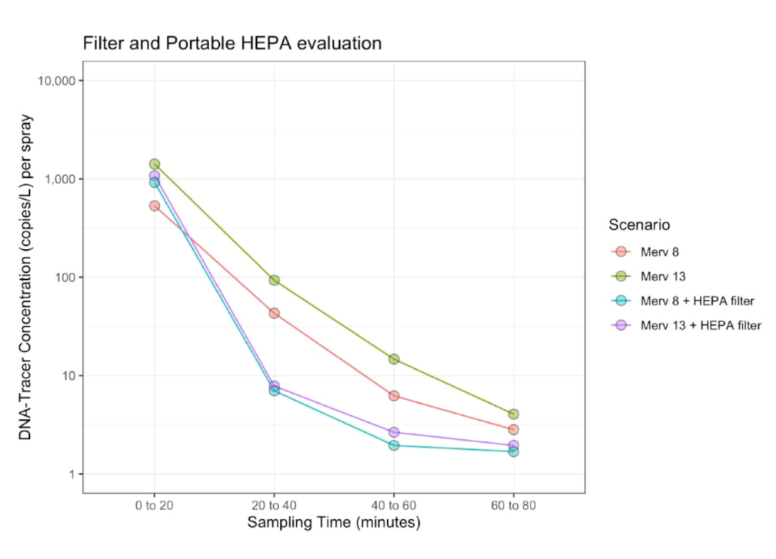
Releasing DNA-tracer virus surrogates into indoor air showed little impact from upgrading main filters—but significant improvements with standalone room filters. (Graph provided by SafeTraces™)
Indoor Air Quality
Indoor air quality (IAQ) is one of the leading building wellness buzzwords today—and for good reason. Tuning indoor air for the appropriate work environment creates one of the greatest opportunities for supporting both the cognitive and physical health of occupants, with an especially strong level of confidence.
Consensus is that ventilation is critical in the spread of the novel coronavirus. Physical barriers (i.e. masks) work because COVID-19 is spread via aerosols and droplets. It seems that wiping down surfaces might make occupants feel more comfortable—and that’s important, too—but contaminated surfaces, or fomites, are not the primary vector to worry about during this current pandemic.
While the science is still developing, studies are also emerging that indicate there may be little point in upgrading main filters beyond the MERV 11-13 range or using special technologies at the air handlers if your goal is to reduce viral numbers in the air traveling through the building. It is difficult for viral particles emitted by someone in a building to successfully travel to another room. Those particles will be:
-
- Mixed with and diluted by the immediate room air;
- Passed through the return system, diluted by all the other return air;
- Mixed with and diluted by outside air;
- Filtered twice, by media and then by wet cooling coils trapping and draining particles to condensate;
- Ejected through the supply fan;
- Divided at every junction in the supply duct system; and
- Exposed to another occupant for a fraction of a second as they walk through any remaining viral particles left in their breathing zone.
This should make building managers think twice before investing in expensive upgrades at their main air handlers, especially if they are already equipped with filters in the MERV 11-13 range.
Lighting and Views
Human beings evolved outdoors, in contact with nature, but today, we spend the vast majority of our time indoors. Generally speaking, people respond positively to light and green views. There is early research showing strong cognitive benefits of biophilia (connecting manmade environments to nature) and views to the outside. Having a window in the workplace has been shown to generate a six percent improvement in productivity. Circadian lighting (matching indoor light temperatures to the time of day) has shown significant sleep quality benefits and, in schools, double-digit increase in standardized test scores.
Thermal Comfort
Personalized thermal comfort has long been associated with productivity improvements. Building occupants may be growing less tolerant of fixed temperatures in their workplaces, and we will see a growing demand for adjustability in thermal environments. It is difficult to micromanage temperature to the individual level (versus room, suite or floor level), but temperatures in the low 70s Fahrenheit seems to produce the most productive workforce.
Noise and Sound
Productivity is eroded dramatically when we try to process multiple conversations. In the post-pandemic office, property professionals can expect tenant demands to include better control of distractions and interference, and a desire for variability depending on the worker and task at hand. Some tasks (and people) favor a high-energy space, but others require peace and quiet. This is a strong productivity factor that employers and their landlords should prioritize.
Active Design
The expectation that people should park themselves at a single workstation for the day may be a thing of the past. It is natural for people to seek variability in their workplaces depending on their moods, needs and type of work—and there are extended benefits of having access to movement and physical activity, even if only briefly. Future workplaces will provide more freedom to move, circulate and exercise.
Personal Fitness and Health
The pandemic has made people more aware of their own personal health and the impact of their surroundings. Products, services and training that address personal health will be in demand. Key factors for personal health include stress management, sleep hygiene, hydration, nutrition, exercise and resilience to infection and disease. Employers, property professionals and workspaces that support these needs can drive better outcomes for occupants, leading to enhanced satisfaction levels and improved tenant retention.
Running the Numbers
All of these elements offer potential productivity benefits to businesses, which can significantly improve their bottom lines. Science already exists to quantify these benefits. (Click here for a chart that provides an overview, courtesy of Simon Turner and Building Cognition LLC.)
While individual building results may vary, research shows the following potential for productivity gains from these elements:
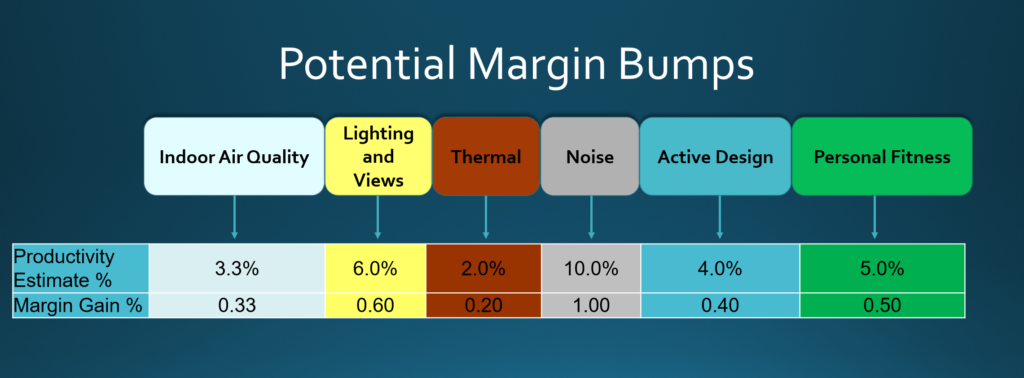
Margin gain assumption: Existing 10% margin (Courtesy: Simon Turner, Building Cognition LLC)
The exact impact for tenants will depend on the building’s environmental baseline: the existing ventilation rates, architectural details and—to a large extent—the existing tenant culture. By assessing potential for improved productivity, adapting the building’s appeal in key areas and marketing the correlation between productivity and margin gains to prospective tenants, commercial buildings can be much more attractive destinations. Done successfully, the building operator will become a true partner and trusted real estate advisor for the tenant.
Opportunity Awaits
There is great opportunity waiting on the other side of the COVID-19 pandemic. Owners and managers of commercial properties—and tenant decision makers—can emerge wiser, more educated and more technically adept at tackling the spread of disease. It all comes down to building management policies that prioritize ventilation, lighting, workplace choices and a culture of health and wellness. Property professionals and tenants should take a cue from recent events to implement fundamental building optimization practices that enable a healthier, more productive and more resilient workplace experience.
About the Authors
Brenna Walraven is the president & CEO of Corporate Sustainability Strategies, Inc. She also is a past chair of BOMA International. Simon Turner is the founder of Building Cognition LLC and a BOMA Life Member.
Original article posted at BOMA International.
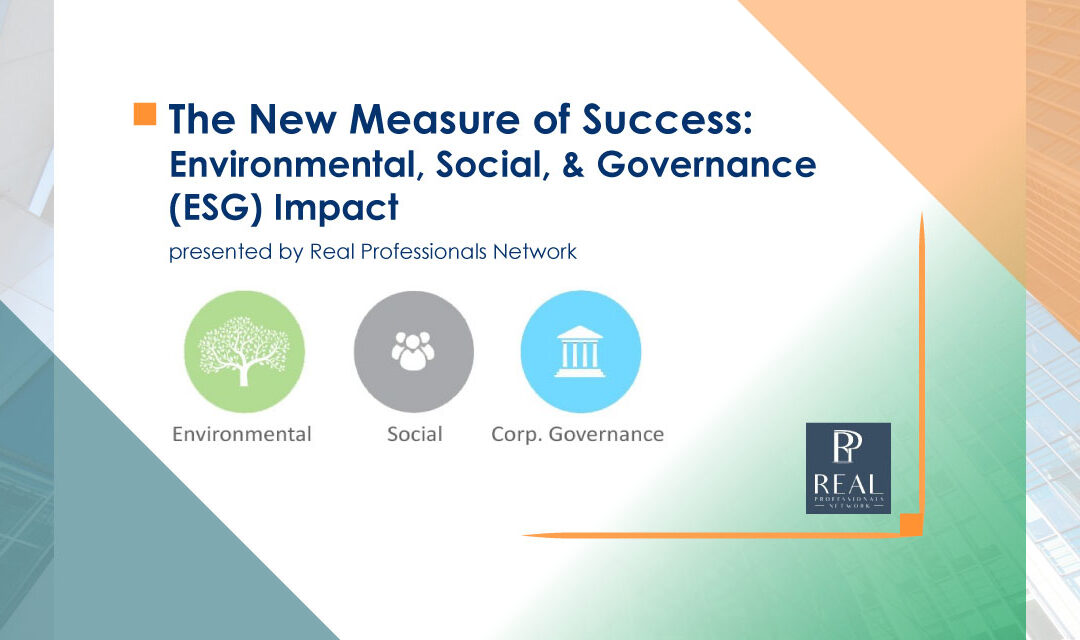
Feb 19, 2021 | Events, Homepage
Presented by Real Professionals Network
ESG (environmental, social, and governance) is a general term used in capital markets and used by investors to evaluate corporate behavior and to determine the future financial performance of companies. — Financial Times.
ESG is the new measure of success for corporations, non-profits, and countries alike.
What You’ll Learn
- Criteria
- Standards
- Implementation
- Sustainability
- Value creation
Panel
Date & Time
March 3, 2021
3:00 PM ET / 12:00 PM PT
Registration
Real Professionals Network
About Real Professionals Network
provides senior level commercial real estate and development professionals a curated industry hub where they exercise their network of relationships in a meaningful way. Our exclusive meetings help Invested Members and their guests stay top of mind, build trust and enhance credibility by sharing important senior level information. For more information visit www.realprofessionalsnetwork.com.
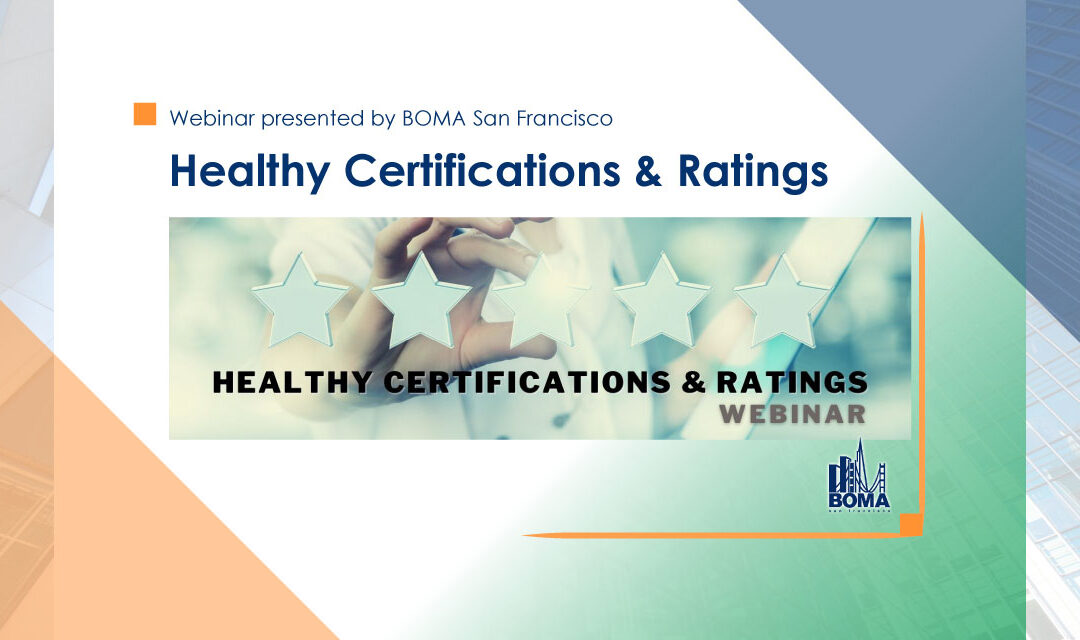
Feb 19, 2021 | Events, Homepage
Webinar presented by BOMA San Francisco
Are you interested in learning more about the certifications you can pursue to market your building as healthy? Come hear from two industry experts, Brenna Walraven, President & CEO of Corporate Sustainability Strategies, and Craig Sheehy, President & CEO of Envision Realty Services, as they impart their knowledge and experience with the Fitwel, WELL, and UL Verified Healthy Building certifications.
They will provide market context for the increase in investor and tenant interest in pursuing such certifications, as well as discuss components, and anticipated costs for each.
Presenters
- Craig Sheehy, CPM, President and CEO, EnVision Realty Services
- Brenna Walraven, BOMA Fellow, BOMI-HP, CPM, RPA, President and CEO, Corporate Sustainability Strategies
Date & Time
February 25, 2021
10:00 AM – 11:00 AM PT
Registration
BOMA San Francisco
About BOMA
Building Owners and Manager Association (BOMA) is the most influential and effective advocacy, recruitment, and training organization for the U.S. commercial real estate industry. BOMA San Francisco represents more than 72 million square feet of office space in San Francisco, San Mateo, Marin and Sonoma counties, and is federated with BOMA International and BOMA California, the voices of the commercial real estate industry in Washington, D.C. and Sacramento. For more information visit www.bomasf.org.







